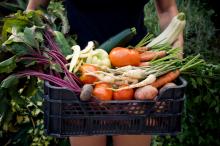Eat Healthier, Save Money

This post is an installment in our 52 Health Hinges series. Remember, “Small hinges swing big doors.”
As I’ve mentioned a few times, it’s finally spring in Minnesota. Can you tell I’m excited?
One of the things I look forward to most are the delicious fruits and vegetables that will take center stage in the meals we cook in the coming months.
Here are three ways to eat healthier and save money this growing season:
1. Farmers’ markets
There’s nothing better than the invigorating hustle and bustle of a good farmers’ market on a summer morning. These markets are a great opportunity to stock up on freshly-picked, in season produce that’s at its peak in flavor and nutrition.
Buying directly from the farmer will usually be cheaper, and supports your local farmer in return.
Each farmers’ market has different rules for what may be sold, but generally a product must be grown, raised, or produced by the farm selling it. Definitions of “local” and “regional” vary but are often defined as being from within a town, county, state, or within a specific radius.
Many farmers’ market farmers use organic methods but are not USDA certified, as the certification process is cumbersome and expensive. These farmers identify themselves as “sustainable producers.” If you have questions about how something was grown, please ask the farmer. They’re usually very happy to discuss their process (please try to catch them when the crowds are at a minimum), and many welcome visitors to their farm to see for themselves.
If you’re in the U.S., you can find a nearby farmers’ market here. For those of you here in Minnesota, you can also go here.
2. Community Supported Agriculture
Another great way to load your plate with fresh, local produce is to support Community Supported Agriculture (CSA). By purchasing a CSA share, you enjoy produce in-season at peak flavor, help the environment by encouraging sustainable farming practices, and support your community by backing local farming.
The Local Harvest website offers the skinny: a farmer offers a certain number of “shares” to the public. Typically the share consists of a box of vegetables, but other farm products may be included. Interested consumers purchase a share (aka a “membership” or a “subscription”) and in return receive a box (bag, basket) of seasonal produce each week throughout the growing season.
This arrangement creates several rewards for both the farmer and the consumer.
Advantages for farmers:
- Get to spend time marketing the food early in the year, before their 16-hour days in the field begin
- Receive payment early in the season, which helps with the farm’s cash flow
- Have an opportunity to get to know the people who eat the food they grow
Advantages for consumers:
- Eat ultra-fresh food, with all the flavor and nutritional benefits
- Get exposed to new types of produce and new ways of cooking
- Usually get to visit the farm at least once a season
- Find that kids typically favor food from “their farm,“ even veggies they’ve never been known to eat
- Develop a relationship with the farmer who grows their food and learn more about how food is grown
Different farms offer different types of shares; from a full box every week (to feed a large family) or every-other-week options for smaller families. Some CSA programs offer half shares.
You could also consider splitting a share with a friend or neighbor. Find more details and a CSA near you at the Local Harvest website.
3. Do it yourself!
Gardening is a great way of growing your own produce in your own backyard. Not only does it provide all of the benefits of fresh produce at its peak, but gardening also provides a creative outlet for stress relief and exercise.
Not sure where to start? First, pick the location (this will help you determine what to grow), then find gardening resources on the internet (like this one), at a local greenhouse, or hit up a neighbor for some advice.
At our house, we’ve had the most consistent luck with cherry tomatoes, zucchini, green beans, and strawberries.
No room for a garden? No problem. There are a ton of community gardens available; find one near you at the American Community Garden Association’s website or check with your city for availability.
Eating fresh, local produce has many benefits beyond just being delicious. Try out one or more of the above ideas and who knows, maybe you’ll find a new hobby or family activity!
In addition, by staying away from the grocery store, you’ll avoid being tempted to buy junk food. This season, make a point to eat local and you’ll support your community and the environment, all while doing something ultra-healthy for yourself.
Sounds like a win-win-win to me. What a great way to “vote with your fork!”
Comments
I am for point 3! Yes, yes,
I am for point 3! Yes, yes, yes! Gardening is for everybody. What is the most important - being a gardener - it is you who decide which fertiliser to use and whether to act with chemicals against pests and plant ilness OR NOT!
Buying fruits in vegetables in directly from farmers is a great idea - but only in ideal world. You can read farmers comments on the their internet comunities forums, where they exchange and interchange their experience and "ways" of defeating pests and using chemicals. It is frightening and thrilling.... I do not know how it looks like in USA but here in Poland there aren't any law barriers and farmers use "what" they only wish to keep plants healthy and produce as much veggies and fruits as possible. And I swear they are far from using natural ways....
Absolutely, Agnieszka. Ask
Absolutely, Agnieszka. Ask questions; know your farmer.
Add comment